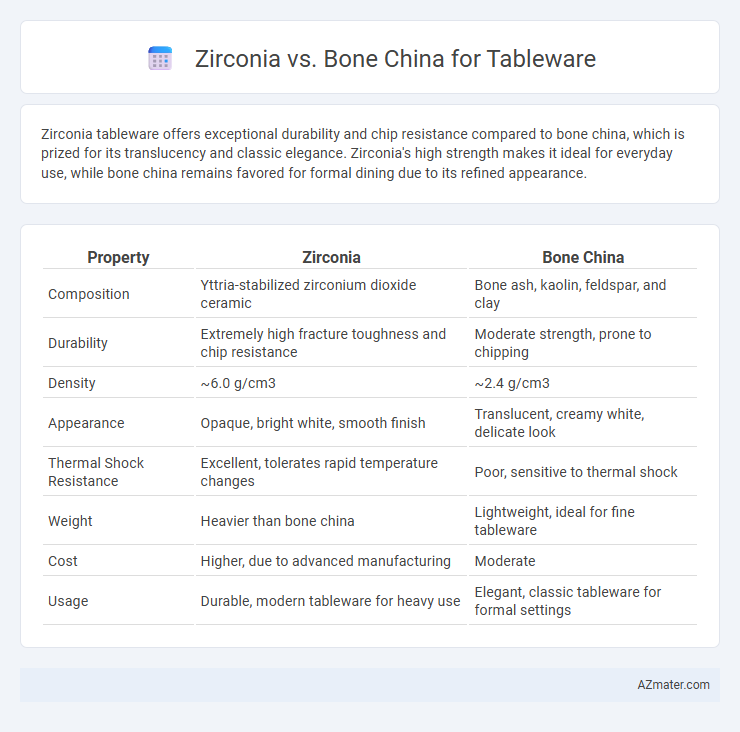Zirconia tableware offers exceptional durability and chip resistance compared to bone china, which is prized for its translucency and classic elegance. Zirconia's high strength makes it ideal for everyday use, while bone china remains favored for formal dining due to its refined appearance.
Table of Comparison
| Property | Zirconia | Bone China |
|---|---|---|
| Composition | Yttria-stabilized zirconium dioxide ceramic | Bone ash, kaolin, feldspar, and clay |
| Durability | Extremely high fracture toughness and chip resistance | Moderate strength, prone to chipping |
| Density | ~6.0 g/cm3 | ~2.4 g/cm3 |
| Appearance | Opaque, bright white, smooth finish | Translucent, creamy white, delicate look |
| Thermal Shock Resistance | Excellent, tolerates rapid temperature changes | Poor, sensitive to thermal shock |
| Weight | Heavier than bone china | Lightweight, ideal for fine tableware |
| Cost | Higher, due to advanced manufacturing | Moderate |
| Usage | Durable, modern tableware for heavy use | Elegant, classic tableware for formal settings |
Introduction to Zirconia and Bone China Tableware
Zirconia tableware is crafted from zirconium dioxide, a durable ceramic material known for its exceptional strength, chip resistance, and smooth, glazed finish. Bone china, made from a blend of bone ash, feldspar, and kaolin, offers a translucent, lightweight, and elegant appearance with high whiteness and a delicate texture. Both materials are popular for premium tableware but differ significantly in composition, durability, and aesthetic qualities.
Composition and Manufacturing Differences
Zirconia tableware is made primarily from zirconium dioxide, a high-strength ceramic known for its durability and resistance to chipping, produced through advanced sintering techniques that enhance its toughness. Bone china consists of a mixture of bone ash, kaolin, and feldspar, fired at high temperatures to achieve its characteristic translucency and lightweight feel. The manufacturing process of bone china involves precise control over the bone ash content to ensure whiteness and delicacy, contrasting with zirconia's focus on maximizing mechanical strength through dense microstructure formation.
Durability and Strength Comparison
Zirconia tableware offers exceptional durability and strength due to its dense, high-quality zirconium oxide composition, making it resistant to chipping, cracking, and thermal shock. Bone china, while known for its elegant translucence and lightweight feel, generally has lower mechanical strength and is more prone to damage from impact compared to zirconia. For long-lasting, resilient tableware that withstands daily use, zirconia outperforms bone china in durability and structural integrity.
Aesthetic Appeal and Design Versatility
Zirconia tableware exhibits a sleek, modern aesthetic with a smooth, polished finish that enhances minimalist and contemporary designs. Bone china offers a classic, translucent beauty with intricate detailing and a warm ivory tone that suits traditional and elegant settings. Design versatility in zirconia allows for sharper shapes and bold forms, while bone china excels in delicate patterns and ornate embellishments, catering to diverse stylistic preferences.
Weight and Handling Experience
Zirconia tableware offers exceptional durability with a surprisingly lightweight design, making it easier to handle during everyday use. Bone china, known for its delicate and elegant appearance, is lighter than traditional porcelain but generally feels more fragile in hand. The weight difference influences handling experience significantly; zirconia provides a sturdier grip, while bone china delivers a refined, lighter touch preferred for formal dining settings.
Heat Resistance and Thermal Properties
Zirconia tableware offers superior heat resistance with a melting point around 2700degC, allowing it to withstand rapid temperature changes without cracking. Bone china, while elegant and durable, has lower thermal stability due to its composition, typically withstanding temperatures up to 1400degC before damage occurs. Zirconia's advanced thermal shock resistance makes it ideal for use in high-temperature environments such as ovens and microwaves, outperforming bone china in maintaining structural integrity under heat stress.
Safety and Food Compatibility
Zirconia tableware is highly praised for its non-porous surface, ensuring excellent food safety by resisting bacterial absorption and chemical reactions. Bone china, while also food-safe, contains natural bone ash, which provides translucency and strength but may be more porous than zirconia, requiring careful maintenance to prevent staining or odor absorption. Both materials are microwave and dishwasher safe, but zirconia's denser structure offers superior durability and long-term food compatibility.
Cost and Value Considerations
Zirconia tableware offers superior durability and chip resistance, often commanding a higher initial cost compared to bone china, which is prized for its delicate translucency and classic aesthetic appeal. Bone china typically provides greater value for formal dining due to its elegant appearance and lightweight feel, while zirconia's robustness makes it more cost-effective for everyday use and heavy handling. Choosing between zirconia and bone china depends on balancing the upfront investment against long-term durability and intended usage frequency.
Environmental Impact and Sustainability
Zirconia tableware offers greater durability and longer lifespan, reducing waste and environmental strain compared to traditional bone china, which is more fragile and prone to breakage. Bone china production relies heavily on animal-derived materials and high energy processes, leading to a larger carbon footprint and ethical concerns. Sustainable tableware choices favor zirconia for its eco-friendly properties, lower resource consumption, and recyclability in ceramic waste streams.
Choosing the Right Tableware: Zirconia vs Bone China
Zirconia tableware offers exceptional strength and chip resistance, making it ideal for everyday use in busy households or commercial settings. Bone china, prized for its delicate translucency and refined appearance, excels in formal dining but requires careful handling due to its relative fragility. Selecting between zirconia and bone china depends on balancing durability needs with the desired aesthetic and occasion.

Infographic: Zirconia vs Bone china for Tableware
 azmater.com
azmater.com